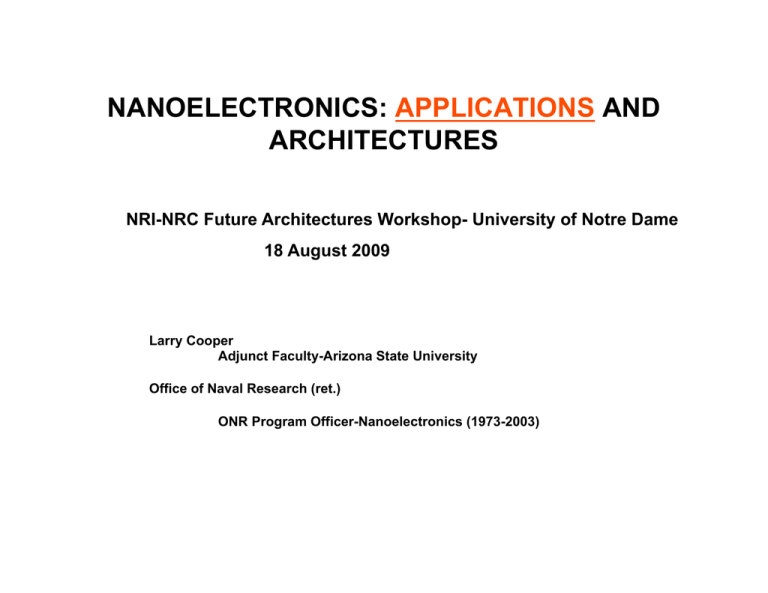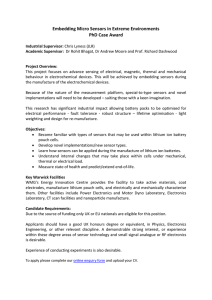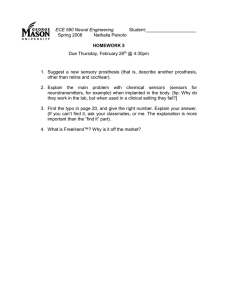NANOELECTRONICS: APPLICATIONS AND ARCHITECTURES
advertisement

NANOELECTRONICS: APPLICATIONS AND ARCHITECTURES NRI-NRC Future Architectures Workshop- University of Notre Dame 18 August 2009 Larry Cooper Adjunct Faculty-Arizona State University Office of Naval Research (ret.) ONR Program Officer-Nanoelectronics (1973-2003) THE NAVY APPROACH TO OBSERVE BUT NOT COMPETE WITH COMMERCIAL INDUSTRIES FOLLOWING“THE “ROAD MAP” TO EXPLORE DIFFERENT MATERIALS, DIFFERENT DEVICES AND DIFFERENT ARCHITECTURES IN ORDER TO: PROVIDE ADVANCED MILITARY SYSTEMS WITH CAPABILITIES IN COMPUTATIONAL SPEED, REDUCED ELECTRICAL POWER AND REDUCED COMPONENT VOLUME BRIEF HISTORY “The Navy Nanoelectronics Program” 1973- New Program Area Radiation Effects in semiconductor devices Contacts and interfaces between dissimilar materials Shrinking silicon devices =>Physics based modeling of semiconductor devices 1977- Major and Focused Program to Support Nanoelectronics Research USER-Ultra Submicron Electronics Research (NERD-Nano Electronics Research for Defense) 1997- ONR Grand Challenge program for Navy impact in 30-50 years Multifunctional Electronics for Intelligent Naval Sensors 1977-USER “Develop a long term basic research program leading to the development of electronics technology based on devices with 20 Angstrom dimensions” (2 Nanometers) Major Components >Materials (thin film) >Fabrication Technologies Silicon Electron Beam Compound semiconductors Ion Beam Ferromagnetic films Patterned self-assembly >Device Physics >Computing Architectures Electronic-Magnetic-Optical Local interconnects Nano- 3D, 2D, 1D, “0D” Parallel processing Physics based device simulations 3 Dimensional Integration 1997-ONR GRAND CHALLENGE “Multifunctional Electronics for Intelligent Naval Sensors” Research Programs To Impact on the Navy in 30 to 50 Years! To develop highly multifunctional nanoscale devices to their ultimate limits of higher speed (1000x), lower power (0.001x), and smaller volume (0.001x) (SPV) and for systems that interactively combine sensing, image processing, computation, signal processing, and communications functions to achieve real-time adaptive response for Navy missions. NANOELECTRONICS IS THE KEY ENABLER Asymmetric Advantage Enabled by Information Superiority • See Further with Greater Clarity • Network Centric Operation Enabled by RF Electronics FLTSAT Space Based RADAR E-3 AWACS Airborne Early Warning Space-Time Adaptive Processing: Complex mission specific circuits Secure Comm: RC-135V Rivet Joint Low power, high fidelity, reconfigurable transceivers E-2C Hawkeye Tier II+ UAV Global Hawk SIGINT GMTI, SAR, STAP, HIS Radiation hard electronics; Broadband, high efficiency sensors Standard Missile Cooperative engagement: Broadband, reconfigurable transceivers Aegis Cruiser TEL Towed Sonar Array Wideband high linearity target discrimination: Broadband, high power, high efficiency transceivers Chemical biological threat detection Small Unit Operations Covert sensing Power constrained operations: Intelligent, Autonomous, Low Power Sensors FUTURE NAVAL CAPABILITIES • Nanoelectronics will be a critical factor for FNCs – AUTONOMOUS OPERATIONS • SENSOR DATA PROCESSING – – – – – – • INTELLIGENT AUTONOMY ELECTRIC SHIPS • INTELLIGENT SENSORS KNOWLEDGE SUPERIORITY & ASSURANCE • IMAGE PROCESSING • INFORMATION MANAGEMENT MISSILE DEFENSE • SMART WEAPONS SENSORS PLATFORM PROTECTION • SMART WEAPONS SENSORS • DISTRIBUTED SENSORS TIME CRITICAL STRIKE • DISTRIBUTED SMART SENSORS • IMAGE & VIDEO ANALYSIS WARFIGHTER PROTECTION • SIGNIFICANTLY ENHANCED SITUATION AWARENESS (automatic response) “Finding the Right Device for the Application” NANOELECTRONIC DEVICES NOW SILICON TRANSISTORS HETEROJUNCTION DEVICES NANOMAGNETIC DEVICES RESONANT TUNNELING DEVICES PROGRAMMABLE METALLIZATION CELL MEMORY (PMC) NEXT? SINGLE ELECTRON DEVICES NANOMAGNETS FOR MQCA SPINTRONIC DEVICES CARBON NANOTUBES SPIN TORQUE MEMORY (DARPA) SCHOTTKY GATE SUBTHRESHOLD TRANSISTORS NEVER? MOLECULAR TRANSISTORS GRAPHENE TRANSISTORS NANOWIRE TRANSISTORS DOMAIN WALL MEMORY/LOGIC RESONANT TUNNELING TRANSISTORS NANO MEMRISTOR MAGNETIC RTD NANO MEMINDUCTOR QUANTUM COHERENT TRANSISTORS NANO MEMCAPACITOR INFLUENCING/DOMINATING FACTORS SPEED-Terahertz Digital Signal Processing AMRFS-Advanced Multifunctional RF Systems POWER-Non-Volatile Reprogrammable Computing Legacy electronics Hybernating or “instant-turn-on-computing” Low dissipation power VOLUME-High performance hybrid integrated systems (SoC) Surveillance Targeting and tracking Bio-inspired Neuro-Computing SPEED Compound Semiconductors High Mobility Low voltage Flexibility in hybrid systems 6.1 Angstrom- InAs/AlSb/GaSb (Lattice matched) InGaAs/InP GaAs/GaAlAs ________________________________________________________________ HFETs Resonant Tunneling Diodes [f(T) > 3 THz] Advanced Multifunction RF-Concept (AMRF-C)-Cellular Antenna Arrays Wideband (10-100 GigaHertz) Digital Antennae for Digital Beam Forming Radar Communications Electronic Warfare SAR-Synthetic Aperture Radar (Colleague question-can we make 400 GigaHertz DSPs?) POWER Nano Magnetics Non-volatile Memory/Logic Dilute magnetic semiconductors (Spintronics) Hybrid magnetic/semiconductor (magnetic state variable?) High mobility semiconductors (HFETs and RTDs) Low voltage High Speed Fewer devices per function Non-volatile Memory NON-VOLATILE ELECTRONICS Nano-magnetics Programmable/Reprogrammable Logic Universal Circuits (?) Battery life Radiation Hard Legacy Electronics Instant-turn-on-computer Magnetoelectronic Reprogrammable Logic • New paradigm for Programmable (and Reprogrammable) Logic • Reduce dependence on ASIC components. • Low cost, multifunctional alternative: – Reprogram by software (data input stream) - hardware upgrade (reprogram chip function) can be achieved by software; fast and inexpensive; test and reprogram to achieve self-healing circuits – Rad hard; multi-GHz operation – Dual-use applications, such as satellite (and other space based systems), missile guidance units, consumer electronics, etc. • Inexpensive alternative: Field Programmable Gate Arrays (FPGA) – Single design: array of identical blocks, each with “programmable” function HHE-Hybrid Hall Effect Device (Research Prototype-sub-micron) Ferromagnetic element AFM image V+ I- I+ V- nonconductive region; radiation damage by FIB • Demonstrate scaling to f = 500 nm • Single F layer - 500 nm by 2.2 m, 55 nm thick Ni0.8Fe0.2 • mobility of S: 4500 • 30 mV output level Mark Johnson, NRL NON-VOLATILE PROGRAMMABLE METALLIZATION CELL (PMC) Programmable Metallization Cell Memory Performance Summary • • • • • • • • • • • • • • Low voltage Low current Low power High speed Low energy High retention High endurance High off/on ratio Good scalability Analog Ron MLC capability High density Integrable Low cost <0.5 V typ. 10 A (to 10 nA) W (to nW) <20 ns write/erase/access pJ to fJ operation >10 years at elevated T >>1012 cycles >105 <10 nm G to tens of programmable 2 bits per cell shown, >2 possible Tb/chip possible at 22 nm with MLC 1 mask over logic, BEOL compliant DRAM-like projections VOLUME Digital functions Analog functions Embedded memory 3 Dimensional integration NANO-ARCHITECTURES? CROSS-BAR CMOL QCA/MQCA (field coupled devices) MOLECULAR (directed self-assembly) PIP (Propagated Instruction Processor) 3 DIMENSIONALLY INTERCONNECTED PROCESSORS NEURO-INSPIRED CELLULAR AUTOMATA SPIN BASED RECONFIGURABLE LOGIC ARTIFICIAL NEURAL NETWORKS CELLULAR NONLINEAR NETWORKS/CELLULAR NEURAL NETWORKS “CNN-UNIVERSAL MACHINE” 1998-GRAND CHALLENGE “Multifunctional Electronics for Intelligent Naval Sensors” (To impact on the Navy in 30-50 years!) Three-dimensional, ultra-dense, stacks of layers, each with a different function, ranging from sensors, to analog-to-digital converters, microprocessors, and memories. Layers intelligently connected with each other i.e. vias or nanowires. Other Functions: - adaptive control - optical communication - energy harvesting A-to-D & D-to-A Converters Microprocessors Memory Other Functions … Devices in each layer featuring sub-10 nm dimensions and lowpower-consumption, and often operating on non-classical phenomena such as quantum, or spin, or single-electron effects. Sensors: IR,UV,Vis,THz Speed-1000X Power-1000X Volume-1000X SOLUTION CNN-UNIVERSAL MACHINE LOCAL INTERCONNECTS PARALLEL COMPUTING NO CLOCK SKEW PROBLEMS NO WIRE DELAY PROBLEMS NO WIRE-TO-WIRE COUPLING ANALOG OR DIGITAL DEVICES PROGRAMMABLE FUNCTIONS INTEGRATED MEMORY MULTIFUNCTION INTEGRATION MULTIPLE LAYERS (INTERCONNECTED) NANOSCALE? 1998-GRAND CHALLENGE “Multifunctional Electronics for Intelligent Naval Sensors” (To impact on the Navy in 30-50 years!) Three-dimensional, ultra-dense, stacks of layers, each with a different function, ranging from sensors, to analog-to-digital converters, microprocessors, and memories. Layers intelligently connected with each other i.e. vias or nanowires. Other Functions: - adaptive control - optical communication - energy harvesting A-to-D & D-to-A Converters Microprocessors Memory Other Functions … Devices in each layer featuring sub-10 nm dimensions and lowpower-consumption, and often operating on non-classical phenomena such as quantum, or spin, or single-electron effects. Sensors: IR,UV,Vis,THz Speed-1000X Power-1000X Volume-1000X Introduction to CNN Dynamics j i The Cellular Nonlinear/Neural Network (CNN) is: • an analog processor array • on a 2D grid • with mainly local interactions. Template configurations I: Spatial feedback xij - state/ yij - output X2 (self) x2 x2 x2 zij - bias uij - input z- bias (space invariant) Template configurations II: Spatial feed-forward xij - state/ yij - output x2 x2 zij - bias uij - input X2 (self) x2 z- bias (space invariant) Gene SAMPLES OF CNN TEMPLATES (GENES) CONTOUR EXTRACTION EROSION CORNER DETECTION HALF TONING HORIZONTAL TRANSLATION GRADIENT DETECTION VERTICAL TRANSLATION DIAGONAL TRANSLATION MANY MORE POINT EXTRACTION THRESHOLDING DEBLURRING _______________________________________________________ Image processing or pattern recognition involves using the programming language to run an algorithm using one or more of the templates. One template run can take 1 microsecond. INTEGRATE DETECTOR WITHIN THE CELL OR THROUGH BUS CONNECTIONS Comparison between an IBM Cellular Supercomputer and an analogic processor 64. 1. 32. 65536 (32*32*64) Power PC 128 x 128 processor with optical input IBM Cellular Supercomputer 2002 An analog-and-logic CNN supercomputer Computing Power ~ 12 * 1012 (TeraFLOPS) Computing Power ~ 12 * 1012 (TeraOPS) equivalent 1. 32. A = 65536 x 1.06 cm2 = 6.9468 m2 A = 1.4 cm2 P = 491 kW P = 4.5 W UNIQUE FEATURES OF CNN-UM IMAGE PROCESSING FULLY PROGRAMMABLE IMAGE PROCESSING COMPUTER ON A SINGLE CHIP POWER DISSIPATION ORDERS OF MAGNITUDE SMALLER THAN WITH DIGITAL PROCESSORS INTEGRATES PHOTODETECTOR SIGNALS DIRECTLY ONTO PROCESSOR CELLS HIGH LEVEL PROGRAMMING LANGUAGE FOR ADAPTING TO ANY DESIRED IMAGE PROCESSING ALGORITHM IMAGE INPUTS CAN BE DIGITAL OR ANALOG (ON-CHIP ADC AND DAC) HIGH FRAME RATES SIGNIFICANTLY LARGER THAN DIGITAL PROCESSING CELL FUNCTION IS EITHER ANALOG OR DIGITAL 45 nanometer silicon technology RTD BASED CNN CIRCUIT SIMULATION (2003) Pinaki Mazumder (U Michigan) SAMPLE LIST OF APPLICATIONS: AUTOMATIC TARGET RECOGNITION – ATR UAV & MAV FOR SURVEILLANCE (BORDER?) AUTONOMOUS VEHICLE NAVIGATION WALKING/CLIMBING ROBOTS MULTIPLE TARGETS (TARGETING AND TRACKING) MONITORING STREAMING VIDEO DATA (ON-SITE PROCESSING) FACIAL RECOGNITION HYPER-SPECTRAL SURVEILLANCE AND INTRUDER IDENTIFICATION COLLISION AVOIDANCE TRAFFIC CONTROL CAMERAS (!) TACTILE SENSORS FOR ROBOTS (3 Dimensional) SOUND LOCATOR TOYS/GAMES NEURO INSPIRED COMPUTING-”ARTIFICIAL EYE” NEUROMORPHIC ENGINEERING Bionics-implanted devices with hybrid digital-analog computing Bionic ear (cochlear) Bionic eye (retina) Monitoring brain functions (control of epileptic seizures) Wireless Nano-power (Low power battery with wireless recharging) Material compatibility Energy harvesting Largest Obstacles: Connection to neuronal networks Determining and replicating cortical neuronal networks Analysis of action potentials of neuronal systems GCL IPL INL OPL V1 VI V IV III II I NANOELECTRONICS AND NEW ARCHITECTURES WHO PAYS? LOOK FOR NEW APPLICATIONS! CELLULAR NONLINEAR/NEURAL NETWORKS MAGNETIC COMPUTER BIO-IMPLANTED PROSTHESES TAKE ADVANTAGE OF SPECIAL PROPERTIES OF THE NEW DEVICES REJECT THE DEVICES WHICH DON’T MEET THE CHALLENGES Sci. Am. May 2009 WHO GETS THE REMOTE CONTROL? Deriving the Algorithms from the Physiology Inner Retina The retina is a multlayered neuronal processing center. Until recently, almost nothing was known about the processing capabilities of the inner retina shown by the box. Our studies have revealed a rich “retinal language” that extracts a variety of space-time features from the visual world. Here’s an example of a living slice of retina resembling the textbook illustration above But all cells are alive and can be studied. The inner retina is comprised of more than a dozen strata. Each stratum carries a unique representation f the visual world These representations can be “read out” by recording electrodes This is a set of 4 of more than a dozen space-time representations derived from electrode measurements Each representation in the inner retina, is carried to the brain by a separate ganglion cell type reading from a separate stratum (above). These represent a full “feature set” of space-time filters that completely characterize the visual world for us. InAs/AlSb/GaSb The All-Purpose Electronics Material Lattice Matched Heterojunctions RTD and RITD-Resonant tunneling devices DSP (>TeraHertz) SRAM Dilute Magnetic Semiconductor Optical detector Infra-red detectors (2-13 micron wavelengths) TeraHertz detector for imaging systems Low power high frequency heterojunction transistor Nanowire transistors and diodes Hybrid devices Multi-value logic Multi-state memory






